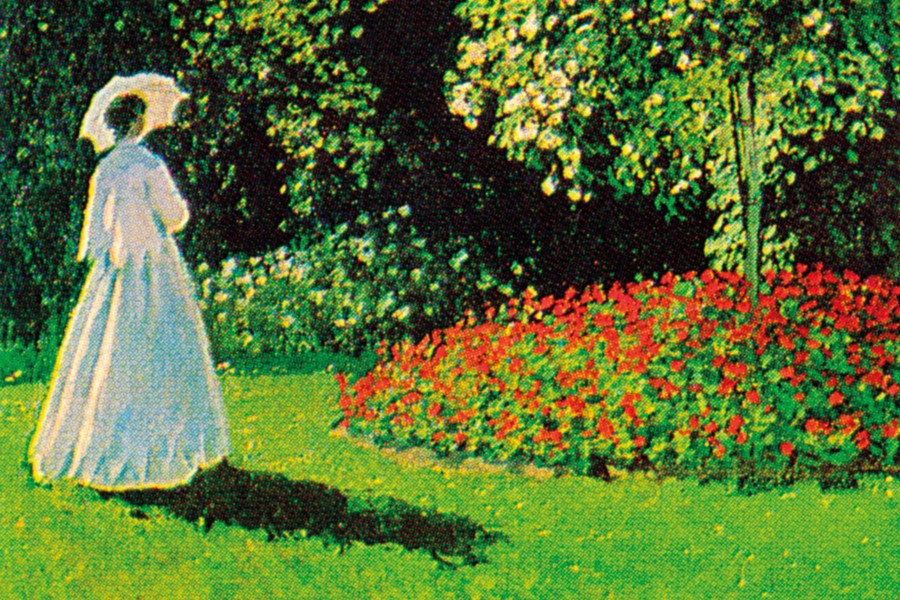Monet’s monumental canvases of his water garden painted in the last decade of his life – the ‘Grandes Décorations’ (1914-26) – are the ultimate expression of the symbiosis between his garden and his art. They would seem to offer a retreat into a world of tranquil beauty, an aesthetic immersion in the garden that obsessed him for the last 30 or so years of his life. Yet for Monet these works carried another layer of meaning, beyond the garden. They were his very personal response to the mass tragedy of the First World War.
Monet was acutely aware of the war. The peace of his garden was sometimes shattered by the sound of gunfire from the battlefields only 50 kilometres away. His stepson was fighting at the front and his own son Michel was called up in 1915. Many of the inhabitants of Giverny fled to safety but Monet stayed behind: “…if those savages must kill me, it will be in the middle of my canvases, in front of all of my life’s work.”
A day after the armistice, Monet wrote to his close friend, the French Prime Minister Georges Clemenceau, proposing to give two works from his ‘Grandes Décorations’ to the nation “to honour the victory and peace”. Plans were then drawn up to house 12 large panels in a specially constructed pavilion in Paris that was to become the Musée Rodin. In 1921, however, the scheme was abandoned for financial reasons, and it was not until May 1927, a few months after Monet’s death, that the great water lily cycle opened to the public in two large oval rooms in the Musée de l’Orangerie, Paris, where they can be seen today. Three of the most beautiful panels from the original scheme, the so-called Agapanthus Triptych, including Water Lilies (1916-26), did not, however, appear in the Orangerie display and were eventually sold separately to three American museums – the Cleveland Museum of Art, the Saint Louis Art Museum and the Nelson-Atkins Museum of Art, Kansas City. Exceptionally, these institutions have allowed these great works to be reunited at the Royal Academy as the grand finale of ‘Painting the Modern Garden’
Painting and gardening were the twin passions that shaped Monet’s life. In one of his earliest paintings, Spring Flowers (1864), over ten species of sumptuously painted flowers, fresh from the garden, reveal not only a brilliant painter at the start of his career but also a precocious botanist. Lady in the Garden (1867), a view of his aunt’s garden at Sainte-Adresse on the Normandy coast, had strong personal associations for Monet because it was here that he learned about gardening in his youth. Its corbeille, or raised bed planted in a single, vivid colour, is typical of the formal planting that was popular in French gardens in the mid-19th century.
‘Aside from painting and gardening I’m good for nothing.’ Claude Monet, 1904
At this time, gardening was emerging as the widespread popular pastime that it remains today. Plant nurseries, catalogues, floral displays in department stores, fairs and exhibitions provided the burgeoning bourgeoisie with the opportunity to create their own private Eden in an increasingly industrial age. Scientific crossbreeding or hybridisation, as well as plant-gathering expeditions to exotic places, greatly enlarged the range of plants available to the modern garden. New bigger and brighter species, of dahlias and chrysanthemums for example, provided artist-gardeners with new ‘palettes’ for their gardens – and their paintings.
Renoir captured his friend Monet painting the dazzling display of dahlias in his first garden in the house he rented at Argenteuil near Paris. This included both the giant Dahlia Imperialis that had been introduced into Europe in 1863, as well as the brilliant red Dahlia Juarezi, imported from Mexico. As a pioneer member of the avant-garde Impressionist group, Monet found the garden an ideal setting to explore the informal modern-life subjects and new notions of composition and colour that were central to the Impressionist agenda.
In his next garden, further from Paris at Vétheuil on the River Seine, Monet grew a forest of sunflowers in a terraced garden adorned with the blue and white pots that travelled with him from one garden to the next (The Artist’s Garden at Vétheuil, 1881).
In 1883, Monet had the chance to pursue his passion for gardening to the full when, with his companion Alice Hoschedé, her six children and his two sons from his first marriage, he rented Le Pressoir, a long pink house with green shutters and extensive grounds, in the village of Giverny about 50 miles from Paris. Although Monet made his garden with the express intention of providing motifs to paint, for the first 15 years that he lived there, with few exceptions, he did not paint the garden but put all his energies into creating it, doing the digging, weeding and planting himself while the children did the watering. In 1890, he bought the property and, as he grew famous and wealthy, he spent a fortune on plants, employing more and more gardeners.
‘These water landscapes have become an obsession’ Claude Monet, 1908
Monet designed his garden with the eye of a painter. Parallel beds were densely planted in blocks of colour, like paint boxes. Several visitors to the garden, among them the critic Arsène Alexandre, noted the carefully orchestrated sequence of brilliant colours like “a flower palette before him to look at all year round, always present, but always changing.” Although the scheme followed an overall geometric structure, within the sections Monet planted loose drifts of colour that almost certainly reflect the ideas of the English garden designers William Robinson and Gertrude Jekyll, who both promoted a new informal approach to gardening that found its truest expression in the English cottage garden. Robinson’s influential book The Wild Garden had first been published in 1870 and Monet read Jekyll’s articles in Country Life.
A sea of the purple Iris germanica, one of Monet’s favourite flowers, fills The Artist’s Garden at Giverny (1900, from the Musée d’Orsay, Paris). Like other flowers Monet loved – tree peonies and chrysanthemums, for example – the iris originated in Japan. Monet embraced the vogue for japonisme, as did many of his contemporaries, and was an enthusiastic collector of Japanese prints. The arched shape of the bridge that he designed for his new water garden (The Pond with Water Lilies, Harmony in Green, 1899) certainly owed something to prints by Hiroshige (Wisteria at Kameido Tenjin Shrine, 1856).
In 1893, Monet acquired an extra plot of land and applied for planning permission to divert water from the small river Ru to create a water garden. Overcoming the objections of local farmers, who feared his aquatic plants would poison the water and kill their cattle, Monet planted irises along the water’s edge, covered the Japanese bridge in wisteria and filled the pond with the new hybrid pink and red water lilies, cultivated by the specialist grower Joseph Bory Latour-Marliac. The pond was extended in 1901, greatly enlarging its original size.
For the last 20 years of his life, the water garden was Monet’s obsession and his exclusive subject. At first he concentrated on the Japanese bridge spanning the dense carpet of lilies below, but then his gaze shifted to the surface of the water alone, excluding the banks and surrounding vegetation. He would rise at four to observe the play of dawn light on the water and then, as the day progressed, capture the subtlest shifts of light on water, lilies and reflections of clouds. From 1902 to 1908 he developed a series of paintings of the pond, working on several canvases at once to establish relationships between them, a process that caused him much anguish. Finally, the series was exhibited at the Durand-Ruel gallery in Paris in 1909 under the title ‘Paysages d’eau’ (Water Landscapes) to great acclaim. Critics were struck by the radical nature of these compositions that seemed to float free of conventional notions of perspective – in the words of the critic Roger Marx: “No more earth, no more sky, no limits now”.
In the great panoramas of his final decade boundaries disappear completely in an enveloping continuum of light, air and water. Although nature was always his starting point, Monet now no longer painted directly from the motif but worked in his studio, relying on memory and his profound visual knowledge of his garden. Trails and dabs of paint, and dragged and scumbled surfaces imbue these canvases with a lyrical expressiveness that looks forward to the great abstract artists of the 20th century and remind us how misguided it is to pigeonhole Monet as exclusively an artist of the 19th century. Freed from the need to depict individual plants, his art in his final years acquired an immense painterly freedom and is, in a way, about art itself. Yet, at the same time, Monet’s passion for gardening was undiminished to the end. We learn from a journalist visiting him in the last year of his life that he had just received water lily bulbs from Japan and was waiting for a delivery of expensive seeds that would produce brilliantly coloured flowers. After all, as Monet claimed: ‘My garden is my most beautiful work of art.’
Painting the Modern Garden: Monet to Matisse is open from 30th Jan–20th April 2016 and is co-organised by the Royal Academy of Arts and the Cleveland Museum of Art. This is an abridged version of an article that was first published in the Winter 2015 issue of RA Magazine.
JM Finn & Co has been a Premier Corporate member of the Royal Academy since 2012.



